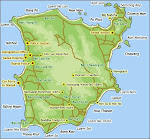
From before Christmas until we left Samui on 2nd January the weather was not good. Uniformly grey, overcast skys allowed only infrequent periods of weak sunshine to filter through. We had a couple of nights of bucketing rain and several days of that fine, heavy drizzle that wets you through before you know it. To make matters much worse, the whole meteorological ensemble was accompanied, on most days, by strong onshore winds, choppy seas and high tides.
If we had intermittent rain at sea level it must have been chucking it down at the top of Samui's mountain on what remains of its rainforest. I know this not because of my passing familiarity with the water-cycle, but because the volume and velocity of water in the stream (klong) that appears during every monsoon and usually exits to the sea close to our near neighbours at The Waterfront, decided this year to straighten out and carve itself an new anus through our beach.
Planted when the hotel opened four years ago, this palm required Tik's intervention to survive. We have to hope the bar's decking doesn't need the same treatment in the coming days.
Tik directs kitchen staff and guests to lash our threatened baby palm to our biggest
Saved for now, but survival not assured
Assuming a mass of around 2000kg/cubic metre for our wet-packed, beach sand I reckon that we lost at least 500 ton to the combined effects of the weather and tides over a ten day period. Baan Bophut's beach will, of course, return to its normal, gentle slope to the sea once the klong's velocity and pressure gradient reduce. And that requires the period of clear, post monsoon weather that Samui is about to enter.

















No comments:
Post a Comment